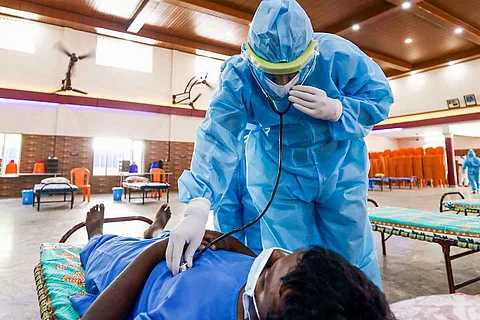

It has been nearly one year since India reported its first COVID-19 case, co-incidentally from Kerala. On January 30, 2020, a student from China’s Wuhan, the then epicentre of the disease, tested positive for novel coronavirus in the state. Kerala presently has the most number of COVID-19 patients, with Ernakulam registering the highest active cases, at 10,450 (as on Tuesday).
According to the Union Health Ministry, as on January 25, India’s active caseload stood at 1.84 lakh, of which, Kerala accounted for 39.7% (7,312) the total active cases, followed by Maharashtra (46,057) at 25%. And among the 20 districts in India with the highest active cases, 11 are from Kerala, including Ernakulam, Thiruvananthapuram, Alappuzha, Kottayam and Pathanamthitta, reported NDTV.
In a recent statement, the Cochin Chapter of Indian Medical Association (IMA) expressed concern over the number of cases, stating, “It is concerning that the test positivity rate in Kerala is increasing (12.48%), COVID-19 ICUs are getting filled up and the highest percentage of COVID-19 patients in the country are in Kerala.”
It also expressed concern over infections in Ernakulam in particular, noting, “The rising (COVID-19) cases in Ernakulam district, a travel hub of Kerala, is worrying.” "The chances for more infection reaching the district is very high as it has a well-knit air, water, rail connections and has highly populated commercial zones and economic centres," the association of doctors in India said.
Among the districts, Ernakulam has the highest number of active COVID-19 (10,450), followed by Kottayam (6,827) and Kozhikode (6,792), as on January 26.
Notably, Ernakulam — which is one of the prime tourism hubs in Kerala, has one of the busiest airports in the country and has a tier-two city like Kochi — was one of the few districts that had managed to contain the spread of the disease in the first few months of the pandemic. Even when the Indian government’s Vande Bharat Mission brought passengers back to the country, Ernakulam managed to keep a check for some time.
From two-digit figures since March, the active cases in the district crossed the 100-mark (104) on June 21, the 1,000-mark (1,065) on August 4, and then the 10,000-mark (10,299) on October 4. Although the cases saw a marginal dip (between 8,000 and 9,000) from November to mid-January 2021, it rose, touching the 10,000-mark once again.
Although medical experts in the state cannot conclusively diagnose the reason behind the rise, they point to the demography and urbanisation of the district, especially Kochi. According to the 2011 Census, with over 32 lakh people, Ernakulam is the third-most populous district in Kerala, after Malappuram (41 lakh) and Thiruvananthapuram (33 lakh).
“With a host of theatres and malls, Ernakulam is one of the biggest metro cities in Kerala. So with growing urbanisation, mobilisation, closed-door shopping and other social interactions are more,” pointed out Dr Padmanabha Shenoy, a rheumatologist based in Kochi.
Besides, the huge population of young people in Kochi, the city is also a business centre unlike other districts, which mostly have government offices. “Everyone here is moving as part of their work, apart from high mobilisation among the socially-active young population. So chances of spreading are high. Also, since gatherings up to 100 people have been authorised, such events could potentially become another cluster where the virus is spreading like wildfire," said Dr Rajeev Jayadevan, Convenor of Scientific Committee of IMA Cochin chapter.
However, most of these are routine tests rather than a symptoms-based test, said the official. Routine tests are carried out when patients who don't have symptoms of COVID-19 are also tested. “So, a majority of such tests will be negative; but this will get added in the state's COVID-19 data," said Dr Rajeev.
Almost every private hospital in the district does testing, each carrying out at least 200-300 tests per day. “These are samples of people not only from Kochi, but those who come from districts and states to some treatment,” added Dr Shenoy.
The district official, on the other hand, argues that peak should be analysed in a scientific manner. The test positivity rate or TPR (percentage of persons in a group of individuals who test positive for the virus) and case fatality rate (proportion of people who die from the disease) should be factored in, the official said.
“As on January 25, our TPR stood at 11%, which is the sixth in the state. Our case fatality rate is 0.36%, which is lower than the state average of 0.4%. This is because we have been doing more tests, identifying people with COVID-19 as early as possible and quarantining them,” said the official, adding, “Yes, ideally, we should be testing more, at least 12,000 samples per day.”
Kerala currently tests between 50,000 and 60,000 samples per day, barring Sundays, when it goes down to 30,000. A major proportion of the tests are carried out by private labs, which are closed on Sundays.
“About 60,000 to 65,000 samples is good enough, but these are antigen tests, which are highly likely to yield false negatives and most COVID-19 cases go undetected. That is why experts have been rallying around, demanding more RT-PCR test,” said Dr Shenoy.
According to the Ernakulam district official, although they have been insisting on RT-PCR (real-time reverse-transcriptase- polymerase chain), which is the gold-standard testing kit for COVID-19, people prefer antigen tests. “It is cheaper and the turnaround time is lesser,” the official said.
“Our Intensive Care Units (ICUs) are not overburdened and the fatality rate is low. We would be concerned if it is not. But, people need to take care,” the official added.